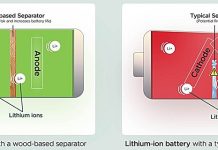
Electric cars, scooters and bikes are everywhere. Are they safe?
A Northeastern expert breaks down the safety of EV and lithium-ion batteries when they encounter water.
It is highly unlikely that a Tesla submerged in a pond in a recent fatal accident in Texas posed a threat of electrocution to its driver or rescuers, a Northeastern University expert says.
Angela Chao, 50, CEO of a shipping company and sister of former transportation secretary Elaine Chao, died in her Tesla last month after her car went into a pond on a Central Texas ranch.
The vehicle went completely under water, according to according to a report acquired by the Austin American-Statesman, and it took firefighters about an hour to extract Chao from the car. She was pronounced dead at the scene.
To get into the Tesla, firefighters stood atop the submerged vehicle, according to the report, while trying to break inside the car through its windows. A tow truck was unable to pull the car to the pond’s bank because its chains were not long enough.
Can an electric vehicle submerged in water pose a risk of electrocution? Were the rescuers in any danger?
Sanjeev Mukerjee, professor of chemistry and chemical biology and affiliated faculty in the department of chemical engineering at Northeastern, says that battery compartments in electric vehicles such as Tesla are completely sealed and well protected.
Most electric vehicles, according to the U.S. Department of Energy, like most portable consumer electronics such as smartphones and laptops as well as electric scooters and e-cigarettes are powered by lithium-ion batteries. Lithium-ion batteries store more energy per unit mass and volume and have a high power-to-weight ratio, high energy efficiency, good high-temperature performance, long life and low self-discharge.
An EV battery, Mukerjee says, may get damaged in an accident or punctured by a sharp object. In that case, the electrodes of the opposite charge might touch each other due to damage, which can start a runway reaction.
The battery would start to overheat due to all the electricity being released at once in the uncontrollable process. The temperature of the battery can quickly reach 900°C, or more than 1,650°F, Mukerjee says, and it can catch fire or explode.
When an electric vehicle goes under water, Mukerjee says, the water is unlikely to enter the battery compartment.
“There are codes and standards relating to electric vehicles, which particularly deal with a battery pack and how it is protected and sealed,” he says.
A vehicle manufactured in the U.S. would fully comply with those requirements. In the case of Tesla vehicles, they are equipped with a number of built-in sensors that can shut the battery off in case of a crash or rollover.
“It’s an engineering marvel,” Mukerjee says.
Mukerjee says he is more worried about electric scooters and electric bikes, which also have lithium-ion batteries.They don’t have good battery protection from damage, unlike electric cars.
“If you find little scooters lying outside in the rain,” he says, “I would be concerned about that [more] than I would be concerned about a car.”
If a car falls into a body of water, it would first impact the charging port, he says, which is designed to isolate itself if it shorts. The same would happen to a damaged cable.
“So there are safety guidelines built into a Tesla at every point,” Mukerjee says.
First responders still have to know that the submerged car is an electric vehicle, he says, before attempting a rescue. The U.S. Department of Energy provides resources for the emergency responders to undergo training on electric vehicle safety and at least some fire academies train their students as well.
“If they properly comply with the safety standards, whether it’s in an accident or a submergence, [they should be safe],” Mukerjee says.
The first thing rescuers need to know, he says, is where the battery pack is and make sure it doesn’t get damaged during the rescue. That may happen if first responders try to lift the vehicle or punch through it with an ax or another tool they may use.
Rescuers should also look out for any high-power busbars—rigid conductors used for connecting together several circuits—that connect parts of the car to its electronic computer.
“They are sealed but if they’re damaged, stay away from them,” Mukerjee says. “Those can give you a bad electric shock.”
The passenger compartment is also isolated from electric shocks and is safe for the driver and passengers.
“Any reasonable electric vehicle [manufacturer] will make sure the passenger is isolated and grounded, because sometimes people are sitting inside the car when the car is being charged,” Mukerjee says.
On land, water is unlikely to cause electrocution from an EV as well. When charging the car at a charging station, the driver should visually check the cable for damage. If the cable is damaged, Mukerjee says, it’s better to not put it in the charging port.
Written by Alena Kuzub, Northeastern University.



